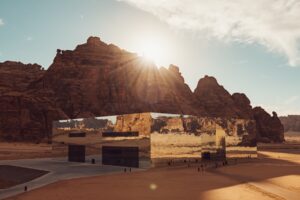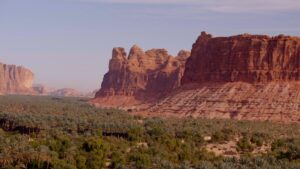
AlUla, Saudi Arabia – 31st Oct 2024: Day 1 of the AlUla World Archaeology Symposium (AWAS 2024) featured insightful discussions on the history of mobile communities and offered a sneak preview of the Middle East’s first showing of masterpieces from the Museo Archeologico Nazionale di Napoli (MANN).
From 34 countries, AWAS 2024 has gathered 17 speakers and 80 delegates across archaeology, cultural heritage and related fields to discuss and debate the symposium theme “Moving forward: past, present and future in the archaeology and heritage of mobile communities”.
In opening remarks delivered in Arabic, Dr Abdulrahman Alsuhaibani, Vice President of Culture at the Royal Commission for AlUla (RCU), said: “We are here presented with a unique opportunity to explore the legacy of mobile communities. This is a truly global gathering bringing together a distinguished group of experts from across the world.”
Day One’s speakers focused on the power of new approaches to overcome challenges in exploring the archaeology and heritage of mobile communities from China to Botswana.
Highlights included keynote addresses by Dr Willeke Wendrich, Professor of Cultural Heritage and Digital Humanities, Polytechnic University, Turin, and Research Professor, Department of Near Eastern Languages and Cultures, University of California at Los Angeles (UCLA); and Dr Stefano Biagetti, ICREA Research Professor of Archaeology, Pompeu Fabra University, Barcelona.
Dr Wendrich said archaeologists studying mobile communities need to be sure they are listening to the members of those communities. For example, she said her early work on mobile communities “was too much about and not enough with.”
She added: “We should think of people we work with as research partners.”
For example, by asking members of Egypt’s Ababda nomad community to draw pictures of the things that mattered to them, she learned that what mattered to them was: things related to camels for the men; and things related to coffee and making a home for the women.
With this approach, she said, archaeologists can better understand the motivations of inhabitants past and present.
Dr Biagetti said new scientific applications can likewise provide clues about mobile and pastoral communities, which tend not to leave nearly as many material traces of habitation as settled communities.
Noting that pastoralists are among the world’s least understood groups, he said that biological and chemical analysis of residual materials such an ash dump or the soil of an abandoned corral can yield insights. For example, he said, at a 200-year-old archaeological site at Seoke, Botswana, these techniques showed where the earlier inhabitants had prepared their food.
The day concluded with a sneak preview for media of Masterpieces of the MANN, an exhibition of 15 stunning artworks from the Naples archaeological museum that will be open to the public from 7 Nov to 14 Dec during AlUla’s Ancient Kingdoms Festival. The masterworks on display range from the imperial to the martial: sculptures depicting Alexander the Great, Hadrian, Trajan and Julius Caesar, but also gladiators’ armour such as a helmet topped by a griffon, and greaves.
This is the first time that these masterpieces are presented in the Middle East. The showing will be a flagship event of the 2024 Ancient Kingdoms Festival and part of the AlUla Moments calendar of events.
AlUla is one of the world’s most active areas for archaeological exploration, with over 30,000 areas of archaeological interest identified and a dozen active research projects across a rich cultural landscape. In recent years RCU-sponsored research by Saudi and foreign archaeologists has shed light on aspects of AlUla’s ancient history, from the monumental structures known as mustatils to large-scale hunting traps known as ‘desert kites’, long-distance ‘funerary avenues’ that linked settlements and pastures, and Neolithic dwellings known as ‘standing stone circles’. Together the studies are showing that the early inhabitants of north-west Arabia were more connected to neighbouring regions than previously believed, and that their society was more complex than had been thought.
The symposium (Oct 30-31) continues today.
AWAS 2024 is AlUla’s second major archaeology gathering.
Where the inaugural AlUla World Archaeology Summit (AWAS 2023) created a space for high-level dialogue on contemporary issues in archaeology and cultural heritage that was both academic and accessible, AWAS 2024 is a more intimate gathering for deeper thematic academic conversations. Summit and symposium will continue to alternate, complementing one another and analogous to an aerial survey one year and site excavation the next.
AWAS 2024 is being held in Maraya, a multipurpose venue at AlUla that holds the world record for largest mirrored building (9,740 glass panels).
- For images and captions please click here
- For more on AWAS visit https://worldarchaeologysummit.com/en, follow @AWASKSA on Instagram and X, or contact media@rcu.gov.sa.
- For Masterpieces of the MANN advance bookings, click on the ‘Register Now’ button here
- For more on the Ancient Kingdoms Festival, click here
___________________________
About AlUla:
Located 1,100 km from Riyadh in north-west Saudi Arabia, AlUla is a place of extraordinary natural and human heritage. The vast area, covering 22,561km², includes a lush oasis valley, towering sandstone mountains and ancient cultural heritage sites dating back thousands of years to when the Lihyanite and Nabataean kingdoms reigned.
The best-known site in AlUla is Hegra, Saudi Arabia’s first UNESCO World Heritage Site. A 52-hectare ancient city, Hegra was the principal southern city of the Nabataean Kingdom and comprises more than 100 well-preserved tombs, many with elaborate facades cut out of the sandstone outcrops surrounding the walled urban settlement.
Current research also suggests Hegra was the most southern outpost of the Roman Empire after the Romans conquered the Nabataeans in 106 CE.
In addition to Hegra, AlUla is also home to ancient Dadan, the capital of the kingdoms of Dadan and Lihyan and considered to be one of the most developed 1st-millennium BCE cities of the Arabian Peninsula, and Jabal Ikmah, an open-air library of hundreds of inscriptions and writings, which has been listed on UNESCO’s Memory of the World Register. AlUla Old Town, a labyrinth of more than 900 mud-brick homes developed from at least the 12th century, was selected as one of the world’s Best Tourism Villages in 2022 by UNWTO.
For more information, please visit: experiencealula.com
____________________________

AlUla landscape. Royal Commission image
____________________________

The AlUla World Archaeology Symposium 2024 (Oct 30-31) takes place at Maraya, a multipurpose venue in AlUla’s Ashar Valley that holds the world record for largest mirrored building (9,740 glass panels). Royal Commission image
____________________________
Article Source: Courtesy AlUla World Archaeology Summit
____________________________
Advertisement

EXPLORE THE ANCIENT ETRUSCANS IN PERSON!
Experience a unique, up-close-and-personal hike among ancient hilltop towns in central Italy. You will walk the sensational countryside of the regions of Umbria and Tuscany, soaking in important sites attesting to the advanced Etruscan civilization, forerunners of the ancient Romans; imposing architectural and cultural remains of Medieval Italy; local food and drink; and perhaps best of all — spectacular scenic views! Join us in this collaborative event for the trip of a lifetime!




